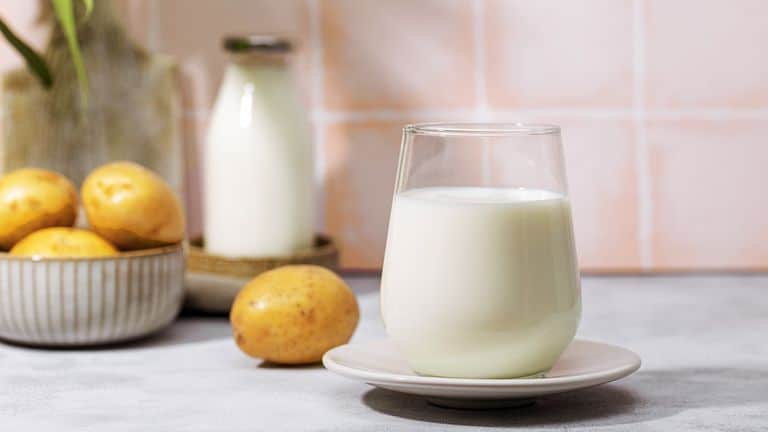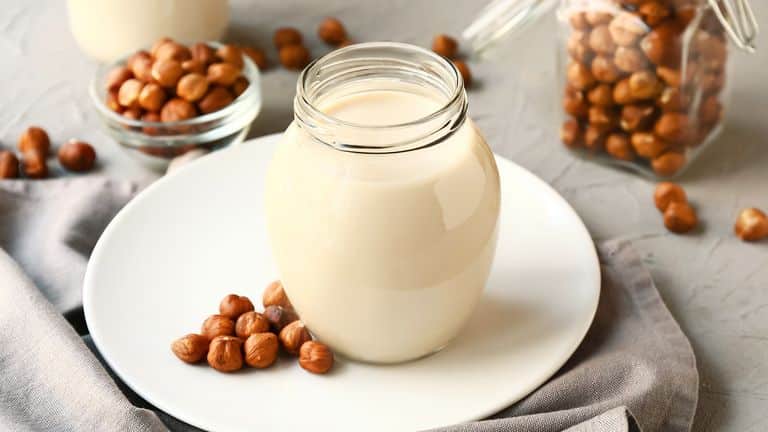You can find many great milk alternatives available, including these 9 options. Make sure to stick with unsweetened varieties and avoid added sugars. Also check that your nondairy milk is fortified with calcium and vitamin B12.

Cow’s milk is considered a staple in many people’s diets. It is consumed as a beverage, poured on cereal and added to smoothies, tea or coffee.
While it is a popular choice for many, some people can’t or choose not to drink milk due to personal preferences, dietary restrictions, allergies or intolerances.
Fortunately, if you’re looking to avoid cow’s milk, there are plenty of nondairy alternatives available. This article lists nine of the best substitutes for cow’s milk.
Table Of Contents
- Why You Might Want a Substitute
- Potato Milk Is the New Milk to Try
- Oat Milk Makes a Great Base for Lattes or as an Addition to Tea
- Hemp Milk Is a Fantastic Option for Coffee Drinks and Smoothies
- Hazelnut Milk Is a Creamy Addition to Baked Goods
- Sesame Milk May a Great Pick for People With Nut Allergies
- Banana Milk Can Help You Get Your Potassium Fix — Just Beware of Added Sugar
- Try Sipping Pistachio Milk, Which Is Diabetes-Friendly
- Flaxseed Milk Is Suitable for Folks With a Dairy or Nut Allergy
- Macadamia Milk Offers Healthy Fats and Fits in a Keto Diet
Why You Might Want a Substitute
Cow’s milk boasts an impressive nutrient profile. It’s rich in high-quality protein and important vitamins and minerals, including calcium, phosphorus and B vitamins.
In fact, 1 cup (240 ml) of whole milk provides 146 calories, 8 grams of fat, 8 grams of protein and 13 grams of carbohydrates.
However, cow’s milk is not a suitable option for everyone. There are several reasons you might be looking for an alternative, including:
- Milk allergy: 2–3% of kids under the age of three are allergic to cow’s milk. This can cause a range of symptoms, including rashes, vomiting, diarrhea and severe anaphylaxis. Around 80% of kids outgrow this allergy by age 16.
- Lactose intolerance: An estimated 75% of the world’s population is intolerant to lactose, the sugar found in milk. This condition happens when people have a deficiency in lactase, the enzyme that digests lactose.
- Dietary restrictions: Some people choose to exclude animal products from their diets for ethical or health reasons. For example, vegans exclude all products that come from animals, including cow’s milk.
- Potential health risks: Some people choose to avoid cow’s milk due to concerns over potential contaminants, including antibiotics, pesticides and hormones.
The good news is that there are many nondairy options available if you want or need to avoid cow’s milk. Read on for a few great recommendations
Potato Milk Is the New Milk to Try

Have you heard of potato milk? It’s made from peeled potatoes that are sliced, boiled, and blended with other ingredients such as water, almonds, and maple syrup. The world’s first potato milk from Dug isn’t yet available in the United States, but you can scour the web for potato milk recipes to DIY it.
Potato milk is thick and creamy, and tastes slightly sweet. It foams nicely for espresso beverages and would make a suitable coffee creamer. What’s more, potato milk is a sustainable choice, as it uses less water than nut milks and requires fewer natural resources than oat milk to produce.
Oat Milk Makes a Great Base for Lattes or as an Addition to Tea

Oats are everywhere these days, so why not in milk as well? Oat milk is ideal for people with a dairy or nut allergy, or people who need a lactose-free option.
Oat milk has less protein than pea or soy milk, but more than others, like coconut, cashew, and rice milk.
Oats naturally supply nutrients such as potassium, which helps promote healthy blood pressure levels, and iron, which is important for preventing anemia — two benefits that the National Institutes of Health notes.
No matter which variety you pick, you can add oat milk to warm beverages like coffee and tea. It has a creamy, rich mouth feel and doesn’t curdle or separate easily, making it an ideal base for a latte. You can use it as you would any plant-based milk in smoothies, warm beverages, or cereal.
Hemp Milk Is a Fantastic Option for Coffee Drinks and Smoothies

No doubt you’ve been seeing hemp everywhere these days, from CBD everything to hemp seeds and hemp seed butter. Add to that list hemp milk, which is typically made with hemp seeds and sometimes extra ingredients such as oats.
When it comes to cooking with hemp milk, it’s naturally thick and creamy, with a slightly nutty flavor. It therefore works best in savory dishes such as casseroles and slow-cooker meals rather than in baking. And of course, brew with it till your heart’s content. Due to its creaminess, hemp milk is also a wonderful addition to lattes, cappuccinos, and other coffee drinks — as well as in smoothies.
Hazelnut Milk Is a Creamy Addition to Baked Goods

If you haven’t tried hazelnut milk, you’re missing out. Hazelnut beverages provide a delightful nutty flavor.
A cup of unsweetened hazelnut milk ranges from 30 to 90 calories, 1 to 2 g of protein, and up to 1 g of fiber.
Try your hand at adding hazelnut milk to your favorite cupcake or pudding recipe. A good hazelnut milk offers a creamy, rich flavor that can replace whole dairy milk, it works beautifully in desserts, smoothies, and of course coffee.
Sesame Milk May a Great Pick for People With Nut Allergies

Allergic to nuts and avoiding dairy? Sesame milk may be your new BFF! Sesame milk has a bit of a toasted yet slightly nutty flavor — even though it’s not a nut.
A cup of the Hope & Sesame milk contains 90 calories, 8 g of protein, and less than 1 g of fiber. Sesame milk is typically minimally fortified. With the Hope & Sesame milk, one serving is an excellent source of vitamin D and calcium.
Many sesame milks are made with white sesame seeds, but some come from black sesame seeds, as with the Three Trees milk and a black sesame milk from Sesamilk. Either is a great option for a latte or as a base for a smoothie, overnight oats, or your morning cereal, says Gold Anzlovar. You can also use it in baked goods that call for any other kind of milk.
Banana Milk Can Help You Get Your Potassium Fix — Just Beware of Added Sugar

Milk from bananas? Yup, it’s a thing! Banana milk isn’t made from nuts like some other plant-based milks, so it may be a safe choice for people with nut allergies, if the brand says that it is nut free.
Some banana milks contain just banana and other spices, while others contain added sugar. Sweetened varieties of banana milk are made with cane sugar and can contain up to 6 g of added sugar. This is where reading the ingredients list becomes important. This means that calorie counts vary widely, from 60 to 80 calories per cup.
You can substitute banana milk cup for cup as you would in smoothies, cereal, baked goods, and even coffee. It does taste like banana. Some banana milk brands are sweeter than others, so keep that in mind if preparing a dish that is on the savory side.
Try Sipping Pistachio Milk, Which Is Diabetes-Friendly

Previously sold mostly as pistachio paste, to which you add water to create your own milk, pistachio milk is now readily available bottled and ready to drink.
Pistachio milk typically isn’t fortified. But in the Three Trees product, for example, you’ll get small amounts of potassium, calcium, and iron — as well as a helping of the heart-healthy monounsaturated fats found in pistachios.
This milk is a good choice for people with diabetes who are avoiding dairy milk or who are following the ketogenic, or keto, diet because you can find milk blends with just a few ingredients and no added sugar.
It tastes delicious on its own, and you can use pistachio milk instead of traditional milk in muffin or quick bread recipes, or blend it into smoothies.
Flaxseed Milk Is Suitable for Folks With a Dairy or Nut Allergy

You’ve had nut milks at your fingertips for years, so why not try a milk made from seeds? Although the milk is nut free, it has a nutty taste. Made from flaxseed, it’s a good choice for people with a nut or dairy allergy.
Blend flaxseed milk into a smoothie or add to your mug of coffee.
Macadamia Milk Offers Healthy Fats and Fits in a Keto Diet

Sweet enough without the need for added sugar, a cup of Milkadamia Macadamia Milk is typically just 40 calories per cup — but with only 1 g protein and less than 1 g fiber. Only some varieties are fortified. Milkadamia’s product, for example, is an excellent source of vitamin D and calcium.
The benefits of consuming macadamia milk are that macadamia nuts are a good source of monounsaturated fats, and they are low in carbohydrates. This low-carb characteristic makes the milk a particularly good choice for people with diabetes who are avoiding dairy milk or who are following a keto diet.
And its creaminess offers many culinary applications. For a nutty flavor, use macadamia milk in lattes and smoothies and to top off a bowl of granola. You can also use macadamia milk instead of coconut milk in golden milk, curry sauce, and a piña colada. Plus, it’s delicious when blended with frozen bananas or strawberries into a nice cream, adds Brenner.
